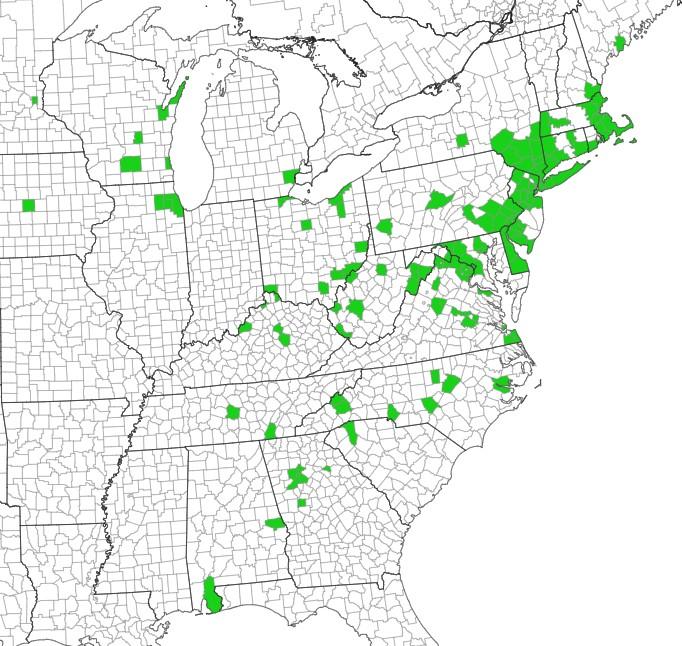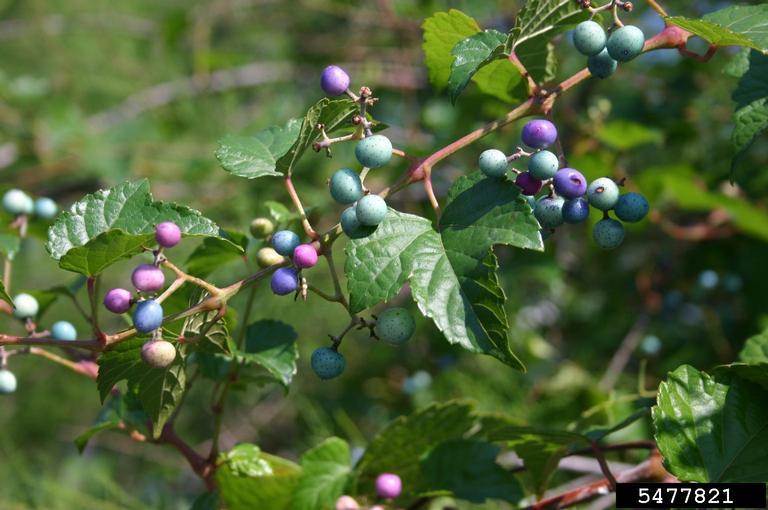Porcelain-berry is an invasive plant reported in widely scattered area in the United States (see map below). But like many other invasive plants that were once cultivated intentionally, chances are that its impact is more wide-ranging than what the map represents. As more observers become familiar with this member of the grape family and understand the differences between it and native species, it is likely that more counties on the map will turn green, and more attention will be paid to its presence.

Those who have discovered it in areas they manage have discovered that once established, this plant can be very difficult to eradicate. The horticultural staff at Lewis Ginter Botanical Garden in Richmond, VA declare that it is “the most pervasive of all invasive plants that we are currently battling” on their grounds.
What is it?
Porcelain-berry, Ampelopsis glandulosa var. brevipedunculata, is a deciduous, climbing, woody vine also styled as “porcelain berry” or “porcelainberry.” It was introduced from northeast Asia in the 1870s as a bedding and landscape plant. It became popular for its tolerance of adverse conditions and its ability to provide ground cover. However, it is an aggressive plant that invades damp, shady areas such as streambanks, forest edges, pond margins, and disturbed areas. It forms dense mats that crowds out native vegetation, making it difficult to discover what, if anything, grows beneath it by shading them out. It can also climb into trees, reaching up to 20 feet in height.
How does it spread?
Porcelain-berry spreads both vegetatively and by animals. Birds and small mammals eat the fruit and spread the seeds through their droppings. The seeds sprout readily and may be viable in the soil for several years. The plant also reproduces asexually by re-sprouting from its roots.
How can I identify it?
The vine has deciduous, heart-shaped leaves that have coarse teeth along the margins. Because porcelain-berry’s stems may closely resemble native grapes superficially, it is important to recognize a few important distinctions that can assist in identification. For example, the bark of native grapes shreds or peels; porcelain-berry’s does not. Additionally, the center of a native grape’s stem is brown; porcelain-berry’s is white. In June through August, the vine develops groups of white flowers which in September and October turn into berries of a variety of colors. Beginning as white fruits, they turn yellow, lilac, green, or turquoise. Observing both the small flowers and the fruits will also aid in identification. Native grape flowers and fruits droop from the vine. Porcelain-berry flowers and fruits are held above the stem, even when the stem is drooping.
See the photo gallery below.
How can I control it?
Porcelain-berry can be controlled by a variety of methods. As with most invasive plants, the best time to control it is during early detection. Repeated treatment will likely be necessary after initial removal because seeds may remain viable in the soil or because unseen root fragments may exist from which new growth will occur. Hand-pulling vines in the fall or early spring will prevent flower buds from producing the following season. If the plants are already producing fruit, take care to ensure that all fruit is collected when the stems are being removed to prevent seed dispersal. Larger vines can be removed with shovels, but care must be taken to ensure that the entire root system is removed to prevent re-sprouting.
Chemical treatment may be necessary to supplement manual or mechanical methods if the infestation is sufficiently large. Cut large vines during the summer and allow to re-sprout before treating with glyphosate. Foliar and basal-bark applications with triclopyr-based formulations are also effective.
For more information:
Learn more about porcelain-berry:
Fact Sheet: Porcelain-berry (Plant Conservation Alliance)
Unwanted and Un-loved: Porcelain-berry! (Virginia Native Plant Society)
Ampelopsis brevipedunculata (North Carolina Extension)
 English
English العربية
العربية Български
Български 简体中文
简体中文 繁體中文
繁體中文 Hrvatski
Hrvatski Čeština
Čeština Dansk
Dansk Nederlands
Nederlands Suomi
Suomi Français
Français Deutsch
Deutsch Ελληνικά
Ελληνικά हिन्दी
हिन्दी Italiano
Italiano 日本語
日本語 한국어
한국어 Norsk bokmål
Norsk bokmål Polski
Polski Português
Português Română
Română Русский
Русский Español
Español Svenska
Svenska Català
Català Filipino
Filipino עִבְרִית
עִבְרִית Bahasa Indonesia
Bahasa Indonesia Latviešu valoda
Latviešu valoda Lietuvių kalba
Lietuvių kalba Српски језик
Српски језик Slovenčina
Slovenčina Slovenščina
Slovenščina Українська
Українська Tiếng Việt
Tiếng Việt Shqip
Shqip Eesti
Eesti Galego
Galego Magyar
Magyar Maltese
Maltese ไทย
ไทย Türkçe
Türkçe فارسی
فارسی Afrikaans
Afrikaans Bahasa Melayu
Bahasa Melayu Kiswahili
Kiswahili Gaeilge
Gaeilge Cymraeg
Cymraeg Беларуская мова
Беларуская мова Íslenska
Íslenska Македонски јазик
Македонски јазик יידיש
יידיש Հայերեն
Հայերեն Azərbaycan dili
Azərbaycan dili Euskara
Euskara ქართული
ქართული Kreyol ayisyen
Kreyol ayisyen اردو
اردو বাংলা
বাংলা Bosanski
Bosanski Cebuano
Cebuano Esperanto
Esperanto ગુજરાતી
ગુજરાતી Harshen Hausa
Harshen Hausa Hmong
Hmong Igbo
Igbo Basa Jawa
Basa Jawa ಕನ್ನಡ
ಕನ್ನಡ ភាសាខ្មែរ
ភាសាខ្មែរ ພາສາລາວ
ພາສາລາວ Latin
Latin Te Reo Māori
Te Reo Māori मराठी
मराठी Монгол
Монгол नेपाली
नेपाली ਪੰਜਾਬੀ
ਪੰਜਾਬੀ Afsoomaali
Afsoomaali தமிழ்
தமிழ் తెలుగు
తెలుగు Yorùbá
Yorùbá Zulu
Zulu ဗမာစာ
ဗမာစာ Chichewa
Chichewa Қазақ тілі
Қазақ тілі Malagasy
Malagasy മലയാളം
മലയാളം සිංහල
සිංහල Sesotho
Sesotho Basa Sunda
Basa Sunda Тоҷикӣ
Тоҷикӣ O‘zbekcha
O‘zbekcha አማርኛ
አማርኛ Corsu
Corsu Ōlelo Hawaiʻi
Ōlelo Hawaiʻi كوردی
كوردی Кыргызча
Кыргызча Lëtzebuergesch
Lëtzebuergesch پښتو
پښتو Samoan
Samoan Gàidhlig
Gàidhlig Shona
Shona سنڌي
سنڌي Frysk
Frysk isiXhosa
isiXhosa